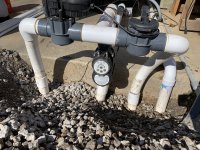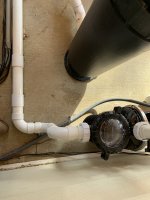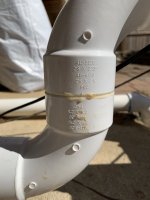Hello Fellow TFP’er
Hope everyone in Boulder is safe, my thoughts are with those impacted yesterday.
Ok, I have been hesitating writing this post but here we go:
I have leaks in plumbing/pool in my 1+ year old IG FG pool. I believe I have leaks in both the suction side between the skimmer and pump and also either a leak in a fitting in the pool or in the pressure side plumping. I believe this has been a long term issue, perhaps since day one. Why, well I’ve always had to add water into the pool on a recurring basis, 2-3 times per week, perhaps 2-3”, never measured. I even had to add water over the winter, I soft closed the pool, safety cover, removed SWG, and set the pump to run at 650 RPM (about 38watts) for the winter, again at least once per week most times twice and again 2-3”.
Ok, issue #1 - air in the strainer/filter
Suction side leak - Since very early I’ve had air in the strainer basket… I’ll run the pump at a higher RPM (example 30-50GPM), clear out the air, release air from the pressure relief valve on top of the filter only to have the little bubbles show up in the strainer and eventually a big air bubble inside the strainer basket within 24 hours. One interesting item of note ,the water level in the basket never goes below the top of the strainer basket and the pump does not loose prime.
A week ago, as one of my pool opening steps I lubed all of the o-rings on the strainer basket lid, the drains both in the basket and the pump and the coupling joining the 2” PVC to the pump. There was no change in the bubbles.
One afternoon after doing some research here on TFP I decided I’d use some of the silicone and let it flow around several of the elbows and coupling joints. I had tried the water over the pump with no luck, Anyway silicon on joints, low and behold when the silicon flowed around one of the coupling joints, no more bubbles. Bubbles would return once the silicon flowed off or was sucked into the pipe. So this past weekend to further test this I used some bathroom silicon to “seal the joints” and initially this seemed to fix the issue.. Now few days later, bubbles are reappearing in the strainer, and since yesterday afternoon the water level dropped in the strainer to the top of the basket once again.. another item of interest is now the filter does not seem to have as much air inside as it has in the past.
Note, I’ve seen one or two thread where someone said VS/VF pumps will get air in the strainer when run on low for long periods.. I’ve wondered about this as equipment is at least 12-18" above the pool.
I have some pic’s to post but I am not sure how to do that, would value guidance.
Ok issue #2 - water level in the pool:
As stated, I’ve had to add water on a frequent, recurring basis, last summer it was 2-3 times per week during the season perhaps 2-3” per week. Didn’t think too much about as it was summer, hot and we were swimming all summer.
Once I started researching more here on TFP it become more apparent this was not normal.
OK, so I tried the bucket test last week, didn’t really understand it, finally found a youtube video that showed me the basics and I’ve now restarted the bucket test.
Over the weekend I placed a rule inside the skimmer so I can see/measure the water lose.. After placing the ruler, filled the pool and turned off the pump, let it set overnight (16:00 - 10:00 next morning) and had just a bit more that 1/2” in the time frame.. Turned pump back on, let it run overnight and lost almost another 1/2+” over night. Seems it didn’t matter pump on/off. I'll redo the pump on/off test once I get my other ruler to measure the bucket.
Now to the bucket, started yesterday afternoon at 16:00 and it’s clear today at 10:00 that pool lost water (1/2"+ on the skimmer ruler) and bucket lost very little 1/8”. I’ll have another ruler coming today to get more accurate measurements in the bucket.
I’ve also ordered some Anderson blue pool dye and one of the little dental syringes with the curved tip as I’ll test at each shell penetration (3 returns, 2 lights, skimmer and venturi) later this week.
Forgot to add - PB did pressure test, had trouble, first time did not hold pressure, seemed to be his brass fittings/connections into PVC, Second time it held pressure (10lbs) more or less for 24 hours... I looked back at my pictures seems it initially had 11lbs, 24 hours later was just a hair under 10lbs.. PB noted, this was the first time he'd been required by city codes to conduct a pressure test... needless to say I was concerned at that comment and even more so now.
I have yet to contact PB, I wanted to get my facts straight before I do that.
Ok, Questions? Suggestions?
Note: there’s no indication of water around the pool/pad, I dug back gravel at edge of pad to expose first 6-8” of plumping as I recalled there were unions just blow ground level. I’m very water sensitive as whoever built this house put it clearly in the worst place possible on this lot as when we exceed 1” of rain per hour we get water running against the house flooding the crawl space. I’ve had city engineer out, he estimates 5+ acres drain thru my property between the house and the back yard, my driveway looks like a river. We’ve installed over 1500’ of French drains, ditches and berms to divert and expedite drainage.
One more item of note: There is a sump next to the pool. I've always checked that as I fully expected given all of the water runoff issues we've encountered there would be water.. there is no visible water... last week I did stick the handle from the brush down the sump and it did come back up a bit muddy, not sure if that is indicator of water below the pool or that I'd just used the brush to brush down the pool and there was some water that ran down the handle once I turned it upside down. I intend to check that out again this week.
Thanks
Craig
Hope everyone in Boulder is safe, my thoughts are with those impacted yesterday.
Ok, I have been hesitating writing this post but here we go:
I have leaks in plumbing/pool in my 1+ year old IG FG pool. I believe I have leaks in both the suction side between the skimmer and pump and also either a leak in a fitting in the pool or in the pressure side plumping. I believe this has been a long term issue, perhaps since day one. Why, well I’ve always had to add water into the pool on a recurring basis, 2-3 times per week, perhaps 2-3”, never measured. I even had to add water over the winter, I soft closed the pool, safety cover, removed SWG, and set the pump to run at 650 RPM (about 38watts) for the winter, again at least once per week most times twice and again 2-3”.
Ok, issue #1 - air in the strainer/filter
Suction side leak - Since very early I’ve had air in the strainer basket… I’ll run the pump at a higher RPM (example 30-50GPM), clear out the air, release air from the pressure relief valve on top of the filter only to have the little bubbles show up in the strainer and eventually a big air bubble inside the strainer basket within 24 hours. One interesting item of note ,the water level in the basket never goes below the top of the strainer basket and the pump does not loose prime.
A week ago, as one of my pool opening steps I lubed all of the o-rings on the strainer basket lid, the drains both in the basket and the pump and the coupling joining the 2” PVC to the pump. There was no change in the bubbles.
One afternoon after doing some research here on TFP I decided I’d use some of the silicone and let it flow around several of the elbows and coupling joints. I had tried the water over the pump with no luck, Anyway silicon on joints, low and behold when the silicon flowed around one of the coupling joints, no more bubbles. Bubbles would return once the silicon flowed off or was sucked into the pipe. So this past weekend to further test this I used some bathroom silicon to “seal the joints” and initially this seemed to fix the issue.. Now few days later, bubbles are reappearing in the strainer, and since yesterday afternoon the water level dropped in the strainer to the top of the basket once again.. another item of interest is now the filter does not seem to have as much air inside as it has in the past.
Note, I’ve seen one or two thread where someone said VS/VF pumps will get air in the strainer when run on low for long periods.. I’ve wondered about this as equipment is at least 12-18" above the pool.
I have some pic’s to post but I am not sure how to do that, would value guidance.
Ok issue #2 - water level in the pool:
As stated, I’ve had to add water on a frequent, recurring basis, last summer it was 2-3 times per week during the season perhaps 2-3” per week. Didn’t think too much about as it was summer, hot and we were swimming all summer.
Once I started researching more here on TFP it become more apparent this was not normal.
OK, so I tried the bucket test last week, didn’t really understand it, finally found a youtube video that showed me the basics and I’ve now restarted the bucket test.
Over the weekend I placed a rule inside the skimmer so I can see/measure the water lose.. After placing the ruler, filled the pool and turned off the pump, let it set overnight (16:00 - 10:00 next morning) and had just a bit more that 1/2” in the time frame.. Turned pump back on, let it run overnight and lost almost another 1/2+” over night. Seems it didn’t matter pump on/off. I'll redo the pump on/off test once I get my other ruler to measure the bucket.
Now to the bucket, started yesterday afternoon at 16:00 and it’s clear today at 10:00 that pool lost water (1/2"+ on the skimmer ruler) and bucket lost very little 1/8”. I’ll have another ruler coming today to get more accurate measurements in the bucket.
I’ve also ordered some Anderson blue pool dye and one of the little dental syringes with the curved tip as I’ll test at each shell penetration (3 returns, 2 lights, skimmer and venturi) later this week.
Forgot to add - PB did pressure test, had trouble, first time did not hold pressure, seemed to be his brass fittings/connections into PVC, Second time it held pressure (10lbs) more or less for 24 hours... I looked back at my pictures seems it initially had 11lbs, 24 hours later was just a hair under 10lbs.. PB noted, this was the first time he'd been required by city codes to conduct a pressure test... needless to say I was concerned at that comment and even more so now.
I have yet to contact PB, I wanted to get my facts straight before I do that.
Ok, Questions? Suggestions?
Note: there’s no indication of water around the pool/pad, I dug back gravel at edge of pad to expose first 6-8” of plumping as I recalled there were unions just blow ground level. I’m very water sensitive as whoever built this house put it clearly in the worst place possible on this lot as when we exceed 1” of rain per hour we get water running against the house flooding the crawl space. I’ve had city engineer out, he estimates 5+ acres drain thru my property between the house and the back yard, my driveway looks like a river. We’ve installed over 1500’ of French drains, ditches and berms to divert and expedite drainage.
One more item of note: There is a sump next to the pool. I've always checked that as I fully expected given all of the water runoff issues we've encountered there would be water.. there is no visible water... last week I did stick the handle from the brush down the sump and it did come back up a bit muddy, not sure if that is indicator of water below the pool or that I'd just used the brush to brush down the pool and there was some water that ran down the handle once I turned it upside down. I intend to check that out again this week.
Thanks
Craig
Last edited:




